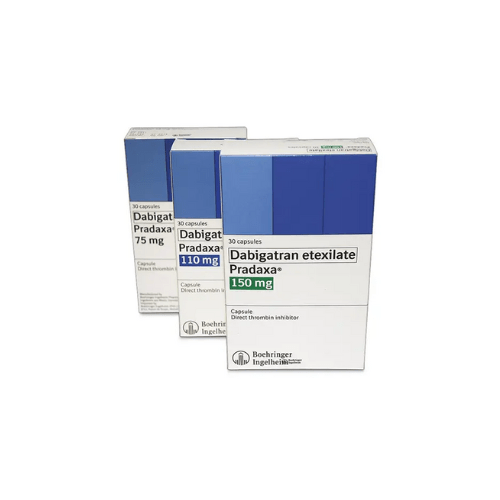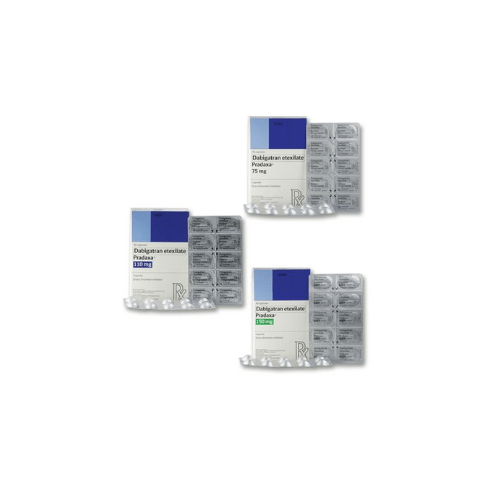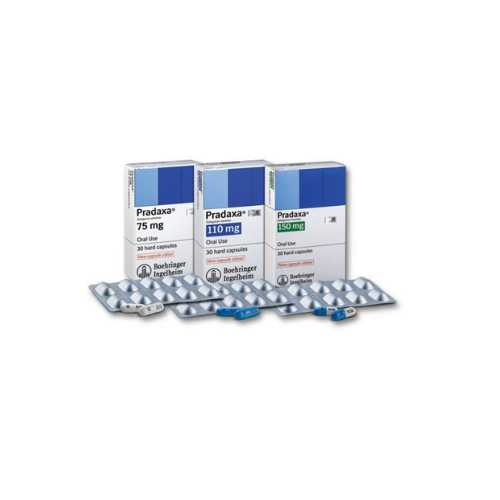Please note: a valid prescription is required for all prescription medication.
Pradaxa® Capsules for Stroke Prevention in Atrial Fibrillation
Sitewide Super Sale - Get 15% off when you buy 3 or more of the same product using the code LESS15 at checkout.
Applies to all products originating from Canada. Maximum quantity limited to a 90-day supply per order.
Price range: $69.30 through $107.10
You save


This anticoagulant capsule helps prevent harmful clots in adults. Pradaxa® reduces stroke risk in nonvalvular atrial fibrillation and treats deep vein thrombosis and pulmonary embolism. Ships from Canada to US with options for those without insurance.
What Pradaxa Is and How It Works
CanadianInsulin.com is a prescription referral platform. We verify prescriptions with your prescriber when required, and licensed Canadian pharmacies dispense your order.
The active ingredient is dabigatran etexilate, a direct thrombin inhibitor. It blocks thrombin’s activity, which helps reduce fibrin formation and clot growth. This medicine is taken by mouth and provides predictable anticoagulation in most adults. It may be taken with or without food.
Stroke prevention in nonvalvular atrial fibrillation is a primary use. It is also used to treat and reduce the risk of recurrence of venous thromboembolism, including deep vein thrombosis and pulmonary embolism. After certain hip surgeries, clinicians may prescribe it to prevent clots when indicated by labeling.
Learn about atrial fibrillation and stroke risk factors in our category guide: Atrial Fibrillation. For clot-related conditions, see this category overview: Blood Clot DVT PE.
Who It’s For
This treatment is for adults with nonvalvular atrial fibrillation to reduce stroke and systemic embolism risk. It also treats established deep vein thrombosis and pulmonary embolism, and helps prevent recurrence after initial therapy. Clinicians may also use pradaxa for pe when treating adults.
People with mechanical heart valves should not use this medicine. Those with active pathological bleeding must not take it. Caution is advised in severe renal impairment, and dosing may differ; defer to the official label. Discuss suitability if you have a history of gastrointestinal bleeding or if you require spinal or epidural procedures.
Dosage and Usage
Adults with nonvalvular atrial fibrillation are generally prescribed a twice-daily regimen per approved labeling. For venous clots, an initial course of injectable anticoagulant is typically given before starting the oral capsules. Timing with surgeries and neuraxial anesthesia requires careful planning by your care team.
For many adults, dabigatran 150 mg twice daily is used per labeling. Swallow capsules whole with a full glass of water. Do not break, open, or chew capsules, because doing so can increase exposure and bleeding risk. Take doses at the same times each day to maintain steady anticoagulation.
If a procedure or dental work is scheduled, your clinician may advise when to stop and restart therapy based on kidney function and bleeding risk. Do not change your dose on your own. When uncertain about your schedule, follow the official prescribing information and your clinician’s guidance.
Strengths and Forms
This medicine is supplied as hard-gelatin capsules. Available strengths include pradaxa 75mg and 150 mg capsules. Some markets also offer different pack sizes or pediatric formulations; availability may vary by pharmacy.
Capsules are typically packaged in moisture-protective bottles with a desiccant or as blister strips. Always keep capsules in their original packaging until use to protect from moisture.
Missed Dose and Timing
If you miss a dose, take it as soon as you remember. Skip the missed dose if the next scheduled dose is within a short interval as directed on the label, and resume your normal schedule. Do not take two doses at the same time.
Consistency matters. Set reminders to help you take doses at evenly spaced times. If you miss doses frequently, speak with your clinician about strategies that can improve adherence.
Storage and Travel Basics
Store capsules at room temperature in a dry place, away from moisture and light. Keep the desiccant in the original bottle and close the cap tightly after each use. Once a bottle is opened, use within the time frame noted on the label. Do not transfer capsules to pill boxes or organizers, as exposure to moisture can reduce potency.
When traveling, carry your medicine in the original labeled container in your hand luggage. Bring a copy of your prescription and your clinician’s contact details. If your itinerary crosses time zones, align dosing to maintain roughly 12-hour spacing. Keep out of reach of children and pets.
Benefits
This treatment provides targeted, direct thrombin inhibition. It offers fixed dosing in many adults and does not require routine INR monitoring. Capsules are taken orally, which many people find convenient compared with injections.
Fewer food interactions occur compared with vitamin K antagonists. Predictable pharmacokinetics allow consistent anticoagulation when taken as directed. Clinical monitoring still matters, especially around surgeries, new medicines, or changing kidney function.
Side Effects and Safety
Below are common pradaxa side effects noted in product labeling:
- Stomach upset or dyspepsia
- Gastritis-like symptoms
- Heartburn or upper abdominal pain
- Nausea
- Easy bruising or minor bleeding
Serious risks include major bleeding, which can occur at any site. Seek immediate help for signs such as unexpected bleeding, black stools, coughing or vomiting blood, or severe headache. Spinal or epidural hematomas may occur with neuraxial anesthesia or spinal puncture. Rare allergic reactions can include rash, itching, swelling, or difficulty breathing. Your clinician will weigh benefits and risks based on your health profile.
Drug Interactions and Cautions
Dabigatran is affected by P-glycoprotein (P-gp) inhibitors or inducers. Strong P-gp inhibitors such as ketoconazole or dronedarone can increase exposure; strong inducers like rifampin can reduce levels. Combining with other anticoagulants, antiplatelets, or NSAIDs can increase bleeding risk. Always review new prescriptions and over-the-counter products with your care team.
Kidney function strongly influences exposure, so dosing and timing around procedures may vary by renal status. If you receive a spinal or epidural procedure, the presence of indwelling catheters increases hematoma risk. Discuss timing of doses before catheter placement and removal according to labeling.
Alcohol may increase bleeding risk when taken in excess. Herbal products such as St. John’s wort and certain supplements may interact; review them with your clinician.
What to Expect Over Time
This medicine acts on the clotting cascade shortly after ingestion. You should not expect symptom relief like a pain reliever; rather, its benefit is clot prevention and treatment as directed. Adherence to the prescribed schedule helps maintain consistent protection.
Some people experience stomach discomfort, which may improve when taken with food. If discomfort persists, discuss options with your clinician. Keep all scheduled appointments, and report planned procedures so timing can be adjusted safely.
Compare With Alternatives
Other direct oral anticoagulants include factor Xa inhibitors such as Eliquis and Xarelto. These options also have label-specific uses for atrial fibrillation and venous clots. Your clinician will choose based on your kidney function, bleed risk, dosing preferences, and procedural plans.
Vitamin K antagonists remain alternatives for select patients. Learn about their role and monitoring requirements here: Warfarin. For background reading on this class, see our overview article: Warfarin Overview.
Pricing and Access
We offer Canadian pricing with US shipping from Canada. Review current options, compare strengths, and see the pradaxa price before you add to cart. You can check out securely and upload your prescription after placing an order.
Looking for ways to stretch your budget? Read practical ideas in this guide: Save on Apixaban Cost. For occasional site-wide offers, visit our Promotions page.
Availability and Substitutions
Both brand and generic options may be available. If a specific strength or pack is temporarily unavailable, your prescriber may recommend a therapeutically appropriate alternative. Pharmacists dispense according to your prescription and local regulations.
Patient Suitability and Cost-Saving Tips
This therapy may suit adults who need oral anticoagulation without routine INR checks. It may not suit people with mechanical heart valves or those with active bleeding. Kidney impairment or upcoming spinal procedures require special considerations under the label.
To reduce overall expense, consider multi-month supplies when appropriate and allowed. Set refill reminders so you do not miss doses. Compare brand and generic offerings, and review your insurer’s formulary if coverage applies; many patients also compare cash options when purchasing without insurance.
Questions to Ask Your Clinician
- Is this the right anticoagulant for my condition and kidney function?
- How should I time doses around surgeries or dental procedures?
- Which warning signs of bleeding require urgent attention?
- What medicines or supplements should I avoid while taking this?
- How long should I continue therapy for my clot history?
- What should I do if I have persistent stomach discomfort?
Authoritative Sources
For complete indications, contraindications, and administration details, review the official documents below.
- FDA Prescribing Information for Dabigatran Etexilate
- Boehringer Ingelheim Product Information
- Health Canada Drug Product Database
Order online from CanadianInsulin for prompt, express, cold-chain shipping and temperature-controlled handling when required.
Medical disclaimer: This content is for informational purposes only and is not a substitute for professional medical advice.
Express Shipping - from $25.00
Shipping with this method takes 3-5 days
Prices:
- Dry-Packed Products $25.00
- Cold-Packed Products $35.00
Standard Shipping - $15.00
Shipping with this method takes 5-10 days
Prices:
- Dry-Packed Products $15.00
- Not available for Cold-Packed products
What is the difference between brand and generic dabigatran?
Both contain the same active ingredient and work the same way according to regulatory standards. Inactive ingredients and appearance may differ. Your prescription determines which is dispensed.
Can I open or crush the capsules?
No. Do not break, open, or crush these capsules. Opening the capsule increases absorption and may raise bleeding risk; swallow whole with water.
How do I handle missed doses?
Take the missed dose when remembered unless it is close to the next scheduled dose, as per the label. Do not double up. Resume the regular schedule at the next dose.
Do I need routine blood tests like INR monitoring?
Routine INR monitoring is not required for this medicine. Your clinician may order other tests based on kidney function, procedures, or safety concerns.
Which medicines increase bleeding risk with this anticoagulant?
Other anticoagulants, antiplatelets, NSAIDs, and strong P‑gp inhibitors can raise bleeding risk. Always review new prescriptions, OTC products, and supplements with your clinician.
Is it safe before spinal or epidural procedures?
There is a risk of spinal or epidural hematoma. Timing of doses around catheter placement and removal must follow label guidance and your clinician’s instructions.
How should I store the capsules after opening the bottle?
Keep capsules in the original bottle with the desiccant and cap tightly closed. Protect from moisture and light, and use within the timeframe specified on the label.
Rewards Program
Earn points on birthdays, product orders, reviews, friend referrals, and more! Enjoy your medication at unparalleled discounts while reaping rewards for every step you take with us.
You can read more about rewards here.
POINT VALUE
How to earn points
- 1Create an account and start earning.
- 2Earn points every time you shop or perform certain actions.
- 3Redeem points for exclusive discounts.
You Might Also Like
Related Articles
Low Income Medication Help: Steps To Reduce Prescription Costs
Key TakeawaysIf low income medication costs are forcing tough choices, focus on the “next refill” problem first.Start with your exact drug name and strengthCompare cash, insurance, and assistance pathwaysAsk about…
Zepbound storage: Keep It Safe With Clear Temperature Rules
This guide explains Zepbound storage so your medication stays effective. You will learn temperature limits, how long doses can stay unrefrigerated, travel practices, and what to do if a pen…
Zepbound and Fatigue: Practical Tips to Ease Tiredness Safely
Feeling drained after starting tirzepatide can be unsettling. Many users describe a mix of low energy, mild aches, and disrupted sleep early on. If you are navigating Zepbound and fatigue,…
Mounjaro Heart Benefits Beyond Weight Loss: What Matters
Key Takeaways Beyond weight: Heart-related effects may involve blood sugar, blood pressure, and inflammation. Evidence is evolving: Large outcome trials help clarify real-world heart risk. Heart rate can rise: Small…



